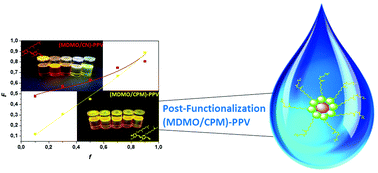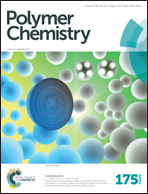Modifiable poly(p-phenylene vinylene) copolymers towards functional conjugated materials†
Abstract
The copolymerization behavior of poly[2-methoxy-5-(3,7-dimethyloctyloxy)-p-phenylene vinylene] (MDMO-PPV) with poly[2-methoxy-5-(carboxypentyloxy)-p-phenylene vinylene] (CPM-PPV) and poly[2,5-dicyano-p-phenylene vinylene] (CN-PPV) in the anionic sulfinyl precursor route is studied and copolymerization parameters are determined. (MDMO/CPM)-PPV shows similar reactivity ratios for both monomers – r1 = 0.74 ± 0.09 and r2 = 0.90 ± 0.10 – when reactions were performed to almost full conversion (>90%). Kinetics of (MDMO/CN)-PPV on the other hand clearly indicate the preference to fully enrich the copolymer with MDMO as r1 = 0.65 ± 0.16 and r2 = 0.015 ± 0.02. Although deviations from the ideal behavior are observed for (MDMO/CN)-PPV, already a small amount of CN leads to significant difference in absorption and emission of the material, allowing to tune the color of the material. Further, post polymerization modification via transesterification of the CPM groups with poly(ethylene glycol) (PEG) or propargyl alcohol via the DCC/DMAP procedure leads to a versatile way of synthesizing a variety of (water soluble) PPV copolymers, without affecting the optical properties of the PPV materials. All reactions are carried out on the anionic polymerization pathway of the sulfinyl route, hence allowing to incorporate these polarity and wavelength tunable PPVs into more complex structures.


 Please wait while we load your content...
Please wait while we load your content...